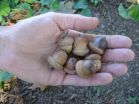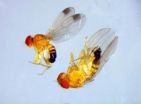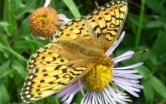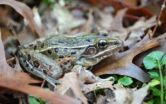(Press-News.org) The northeastern U.S. should prepare for a surge in Lyme disease this spring. And we can blame fluctuations in acorns and mouse populations, not the mild winter. So reports Dr. Richard S. Ostfeld, a disease ecologist at the Cary Institute of Ecosystem Studies in Millbrook, NY.
What do acorns have to do with illness? Acorn crops vary from year-to-year, with boom-and-bust cycles influencing the winter survival and breeding success of white-footed mice. These small mammals pack a one-two punch: they are preferred hosts for black-legged ticks and they are very effective at transmitting Borrelia burgdorferi, the bacterium that causes Lyme disease.
"We had a boom in acorns, followed by a boom in mice. And now, on the heels of one of the smallest acorn crops we've ever seen, the mouse population is crashing," Ostfeld explains. Adding, "This spring, there will be a lot of Borrelia burgdorferi-infected black-legged ticks in our forests looking for a blood meal. And instead of finding a white-footed mouse, they are going to find other mammals—like us."
For more than two decades, Ostfeld, Cary Institute forest ecologist Dr. Charles D. Canham, and their research team have been investigating connections among acorn abundance, white-footed mice, black-legged ticks, and Lyme disease. In 2010, acorn crops were the heaviest recorded at their Millbrook-based research site. And in 2011, mouse populations followed suit, peaking in the summer months. The scarcity of acorns in the fall of 2011 set up a perfect storm for human Lyme disease risk.
Black-legged ticks take three bloodmeals—as larvae, as nymphs, and as adults. Larval ticks that fed on 2011's booming mouse population will soon be in need of a nymphal meal. These tiny ticks—as small as poppy seeds—are very effective at transmitting Lyme to people. The last time Ostfeld's research site experienced a heavy acorn crop (2006) followed by a sparse acorn crop (2007), nymphal black-legged ticks reached a 20-year high.
The May-July nymph season will be dangerous, and Ostfeld urges people to be aware when outdoors. Unlike white-footed mice, who can be infected with Lyme with minimal cost, the disease is debilitating to humans. Left undiagnosed, it can cause chronic fatigue, joint pain, and neurological problems. It is the most prevalent vector-borne illness in the U.S., with the majority of cases occurring in the Northeast.
Ostfeld says that mild winter weather does not cause a rise in tick populations, although it can change tick behavior. Adult ticks, which are slightly larger than a sesame seed, are normally dormant in winter but can seek a host whenever temperatures rise several degrees above freezing. The warm winter of 2011-2012 induced earlier than normal activity. While adult ticks can transmit Lyme, they are responsible for a small fraction of tick-borne disease, with spring-summer nymphs posing more of a human health threat.
Past research by Ostfeld and colleagues has highlighted the role that intact forest habitat and animal diversity play in buffering Lyme disease risks. He is currently working with health departments in impacted areas to educate citizens and physicians about the impending surge in Lyme disease.
INFORMATION:
For more information and how environmental conditions set the stage for disease risk:
Ostfeld, R. S. 2011. Lyme disease: The ecology of a complex system. Oxford University Press
Keesing, F., J. Brunner, S. Duerr, M. Killilea, K. LoGiudice, K. Schmidt, H. Vuong and R. S. Ostfeld. 2009. Hosts as ecological traps for the vector of Lyme disease. Proceedings of the Royal Society B, Biological Sciences 276:3911-3916.
Ostfeld, R. S., C. D. Canham, K. Oggenfuss, R. J. Winchcombe, and F. Keesing. 2006. Climate, deer, rodents, and acorns as determinants of variation in Lyme-disease risk. PLoS Biology 4(6):e145.
Schauber, E. M., R. S. Ostfeld, and A. S. Evans, Jr. 2005. What is the best predictor of annual Lyme disease incidence: Weather, mice, or acorns? Ecol. Appl. 15:575-586
The Cary Institute of Ecosystem Studies is a private, not-for-profit environmental research and education organization in Millbrook, N.Y. For more than twenty-five years, Cary Institute scientists have been investigating the complex interactions that govern the natural world. Their objective findings lead to more effective policy decisions and increased environmental literacy. Focal areas include air and water pollution, climate change, invasive species, and the ecological dimensions of infectious disease. Learn more at www.caryinstitute.org
Lyme disease surge predicted for the northeastern US
Boom-and-bust acorn crops and a decline in mice leave humans vulnerable to infected ticks
2012-03-19
ELSE PRESS RELEASES FROM THIS DATE:
Nano rescues skin
2012-03-19
Nanoparticles containing chitosan have been shown to have effective antimicrobial activity against Staphylococcus saprophyticus and Escherichia coli. The materials could be used as a protective wound-healing material to avoid opportunistic infection as well as working to facilitate wound healing.
Chitosan is a natural, non-toxic and biodegradable, polysaccharide readily obtained from chitin, the main component of the shells of shrimp, lobster and the beak of the octopus and squid. Its antimicrobial activity is well known and has been exploited in dentistry to prevent ...
Novel plastics and textiles from waste with the use of microbes
2012-03-19
New biotechnological and chemical methods will facilitate efficient production of chemicals, materials and fuels from renewable natural resources. The Academy of Finland Centre of Excellence (CoE) in White Biotechnology – Green Chemistry Research focuses on the research and development of microbial cells, or cell factories, for producing new useful compounds from sugars in plant biomass. These compounds can be used, for example, for manufacturing bioplastics or in medical applications.
"By means of gene technology, we can modify microbial metabolism and thereby produce ...
An invasive Asian fly is taking over European fruit
2012-03-19
Coming from the Asian continent, Drosophila suzukii has only been in Spain for a short time. Far away from slipping through into the Iberian Peninsula, it accelerated towards the north of Europe where it has already crossed the Alps. Amongst its preferred target are cherries and red fruits but any type of fruit is suitable for it to lay its eggs. This insect is posing a threat to the fruit of more and more European countries.
"Out of the 3,000 known species of Drosophilae, commonly named the vinegar fly, only two are potentially dangerous to fruit crops. One of them is ...
Survival of the fittest -- ESF hosts session on the challenges of life in extreme environments
2012-03-19
Have you ever wondered how life is sustained in environments like deserts, deep seas or the polar regions? How do organisms adapt and thrive in such harsh conditions, and what challenges do they face as a result of human activities and climate change, especially climate "extremization"? Shedding light on some of these issues is the objective of the European Science Foundation's (ESF) session on 27 March at Planet Under Pressure 2012. The session will look at different aspects of life in extreme environments - from knowledge to sustainable exploitation of new resources under ...
Treating psoriasis to prevent heart attacks and strokes
2012-03-19
Montreal, March 16, 2012 – A clinical study co-led by the Montreal Heart Institute and Innovaderm Research Inc., which was presented today at the annual meeting of the American Academy of Dermatology, shows that a new treatment for psoriasis could be associated with a significant decrease in vascular inflammation, a major risk factor of cardiovascular disease.
Psoriasis is a chronic inflammatory disease of the skin and joints that affects up to 3% of the population. This disease is associated with a greater risk of heart attack (infarction) and stroke. The goal of this ...
Early spring drives butterfly population declines
2012-03-19
Early snowmelt caused by climate change in the Colorado Rocky Mountains snowballs into two chains of events: a decrease in the number of flowers, which, in turn, decreases available nectar. The result is decline in a population of the Mormon Fritillary butterfly, Speyeria mormonia.
Using long-term data on date of snowmelt, butterfly population sizes and flower numbers at the Rocky Mountain Biological Laboratory, Carol Boggs, a biologist at Stanford University, and colleagues uncovered multiple effects of early snowmelt on the growth rate of an insect population.
"Predicting ...
Hiding in plain sight, new frog species found in New York City
2012-03-19
In the wilds of New York City--or as wild as you can get that close to skyscrapers--scientists have found a new leopard frog species.
For years, biologists mistook it for a more widespread variety of leopard frog.
While biologists regularly discover new species in remote rainforests, finding this one in ponds and marshes--sometimes within view of the Statue of Liberty--is a big surprise, said scientists from the University of California, Los Angeles; Rutgers University; the University of California, Davis and the University of Alabama.
"For a new species to go unrecognized ...
Checking off symptoms online affects our perceptions of risk
2012-03-19
You've been feeling under the weather. You Google your symptoms. A half-hour later, you're convinced it's nothing serious—or afraid you have cancer. More than 60 percent of Americans get their health information online, and a majority of those decide whether to see a doctor based on what they find. "Wow, this is an era of self-diagnosis," thought Arizona State University psychologist Virginia Kwan, learning that statistic. How might information accessed online affect individual health decisions?
In a new study, Kwan and her colleagues found that the way information is ...
Researchers uncover molecular pathway through which common yeast becomes fungal pathogen
2012-03-19
TORONTO, ON—Scientists at the University of Toronto have found a molecular mechanism that plays a key role in the transition of Candida albicans yeast into disease-causing fungus—one of the leading causes of hospital-acquired infection. The finding highlights the importance of heat in fungal growth, and provides a new target for drug therapies to counter Candida albicans infection.
Candida albicans is a normally harmless yeast that is present in all humans. It becomes infectious in various genetic and environmental conditions, with temperature as a key determinant. It ...
Increase in Arctic shipping poses risk to marine mammals
2012-03-19
NEW YORK (March 16, 2012)—A rapid increase in shipping in the formerly ice-choked waterways of the Arctic poses a significant increase in risk to the region's marine mammals and the local communities that rely on them for food security and cultural identity, according to an Alaska Native groups and the Wildlife Conservation Society who convened at a recent workshop.
The workshop—which ran from March 12-14—examined the potential impacts to the region's wildlife and highlighted priorities for future management of shipping in the region. The meeting included participants ...
LAST 30 PRESS RELEASES:
Statins significantly reduce mortality risk for adults with diabetes, regardless of cardiovascular risk
Brain immune cells may drive more damage in females than males with Alzheimer’s
Evidence-based recommendations empower clinicians to manage epilepsy in pregnancy
Fungus turns bark beetles’ defenses against them
There are new antivirals being tested for herpesviruses. Scientists now know how they work
CDI scientist, colleagues author review of global burden of fungus Candida auris
How does stroke influence speech comprehension?
B cells transiently unlock their plasticity, risking lymphoma development
Advanced AI dodel predicts spoken language outcomes in deaf children after cochlear implants
Multimodal imaging-based cerebral blood flow prediction model development in simulated microgravity
Accelerated streaming subgraph matching framework is faster, more robust, and scalable
Gestational diabetes rose every year in the US since 2016
OHSU researchers find breast cancer drug boosts leukemia treatment
Fear and medical misinformation regarding risk of progression or recurrence among patients with breast cancer
Glucagonlike peptide-1 receptor agonists and asthma risk in adolescents with obesity
Reviving dormant immunity: Millimeter waves reprogram the immunosuppressive microenvironment to potentiate immunotherapy without obvious side effects
Safety decision-making for autonomous vehicles integrating passenger physiological states by fNIRS
Fires could emit more air pollution than previously estimated
A new way to map how cells choose their fate
Numbers in our sights affect how we perceive space
SIMJ announces global collaborative book project in commemoration of its 75th anniversary
Air pollution exposure and birth weight
Obstructive sleep apnea risk and mental health conditions among older adults
How talking slows eye movements behind the wheel
The Ceramic Society of Japan’s Oxoate Ceramics Research Association launches new international book project
Heart-brain connection: international study reveals the role of the vagus nerve in keeping the heart young
Researchers identify Rb1 as a predictive biomarker for a new therapeutic strategy in some breast cancers
Survey reveals ethical gaps slowing AI adoption in pediatric surgery
Stimulant ADHD medications work differently than thought
AI overestimates how smart people are, according to HSE economists
[Press-News.org] Lyme disease surge predicted for the northeastern USBoom-and-bust acorn crops and a decline in mice leave humans vulnerable to infected ticks




